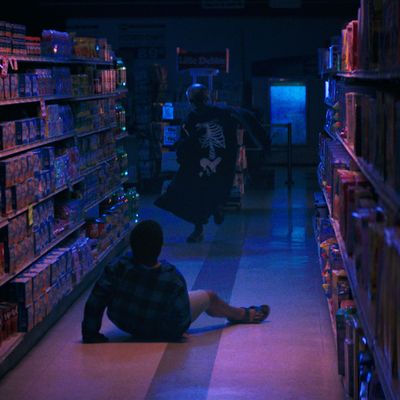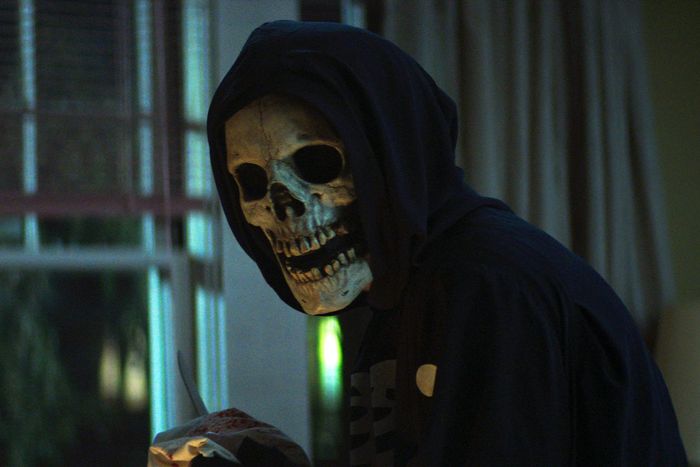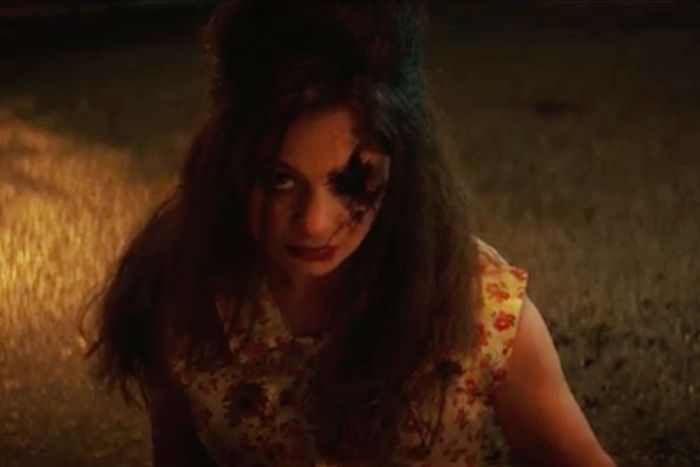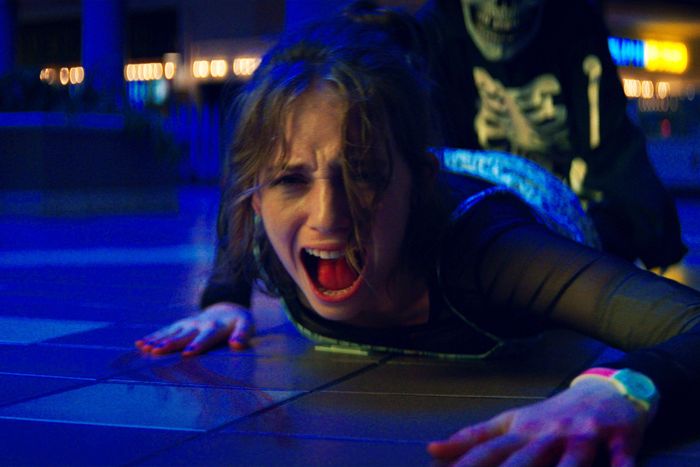
Fear Street is Netflix’s biggest horror gambit to date — a gambit that, in some alternate universe, would have played itself out on the big screen. An interconnected story told across three films, Leigh Janiak’s trilogy adapted R.L. Stine’s young-adult book series into tongue-in-cheek slashers with style to burn. Fear Street: Part One: 1994 follows a group of teenagers in Shadyside, Ohio, as they race to uncover the truth about a witch’s curse that has been triggering gruesome slayings around town. It sets the stage for a second, ’70s-set installment at Camp Nightwing, the site of a horrifying summer-camp massacre, before the third Fear Street visits the 1600s to detail the curse’s origins. Breaking away from recent American horror trends toward art-house approaches and microbudgets, Fear Street is a splashy, cinematic reinvention of a genre that has played so well in theaters. Yet here, the trilogy has rolled out on Netflix with the kind of weekly-release cadence more commonly reserved for television series than film franchises. This wasn’t always the plan.
Originally intended to hit theaters months apart, the Fear Street films were first set up in 2015 at 20th Century Fox by Chernin Entertainment, part of the company’s longtime production pact there. Janiak and her co-writer, Phil Graziadei, had signed on in 2017, and the trilogy entered production in Georgia in early 2019, just as Disney was moving to acquire Fox. By the end of August, the films were in postproduction and the merger had closed. Everyone was tentatively hopeful that a big-screen release would happen the following summer. Then the pandemic hit, and Fear Street fell off Disney’s theatrical calendar.
Fear Street’s team isn’t surprised that Disney balked at releasing the films, all of which are rated R. In addition to the movies’ buckets of blood, sexual content, and coarse language, the Fear Street films revolve around a queer romance. “These movies weren’t Disney movies,” says executive producer Kori Adelson. “And we were never going to neuter them to satisfy their brand goals.”
Some Goosebumps fans will remember Fear Street as the grislier precursor series aimed at young-adult readers — specifically, young women. Adelson estimates she had at least 70 on her shelf. “They were a whole generation’s introduction into horror,” she says. So when she read that Stine was returning to the Fear Street series, she did too, and she was struck by how refreshing she found them, especially given that the books were far lighter than the cinematic horror in vogue in the 2010s. “What was being made, to me, felt excessively dark, that we were taking a lot of joy in killing people,” she recalls. “It represented a really dark side of our culture that didn’t resonate with me at all.”
Adelson saw in Fear Street the potential for a uniquely self-referential throwback. It helped that Stine’s books were treasure troves from a genre perspective — their stories, characters, and kills heavily informed by the author’s own appreciation for big-screen chills. And so she tweeted at Stine, asking after the rights. He wrote back almost immediately, and Adelson told Stine she wanted to help make an R-rated Fear Street film franchise that would evoke the same sense of dread she had felt reading the books as a teenager. “Those were the conversations we had early on, about how not to make Fear Street just nostalgia, but nostalgia with a point, that has a reason to live in this contemporary time,” says Adelson. “A lot of kids feel like they’re screaming into a void and no one’s listening, and I think the Fear Street universe really taps into that idea.”
Early on, Adelson and Stine had been excited by the prospect of mounting a trilogy of films. “We wanted to tell a story that took advantage of the idea of a franchise, that saw sequels not as necessary cash grabs but through a more creative lens,” says the producer. To accomplish this, Adelson needed a director who loved slashers as deeply as she did. She had been “blown away” by Janiak’s feature debut, 2014’s Honeymoon, about newlyweds (Rose Leslie and Harry Treadaway) threatened by sinister forces at a cabin in the woods. She and Janiak met to discuss the overarching Fear Street mythology. “It always felt like there was a witch,” says Adelson, explaining that earlier scripts she had overseen had used such a figure to establish a Shadyside curse. “But Leigh and I immediately agreed that doesn’t make sense in the context of a contemporary film, because we know that witches were just women condemned. That point of view immediately informed the building of this mythology.”
Janiak came in with a pitch for the mythology that split the difference between film and television. “I wanted to tell these complete, cohesive, somewhat individually satisfying stories through the movies but keep the narrative connected and driving throughout all three,” she explains, in order “to make the audience feel like they’re getting something new and complete with each part but also be able to tell this epic story, which is not something that usually happens in horror.” Janiak spared no expense to convince Adelson and Chernin that she could take on the work. She created mixtapes for every character and put together a 70-page look book. “She emerged as the only person that could actually carry this,” Adelson says.
And so Fear Street proceeded under Janiak’s vision, which evolved with each entry, filmed back-to-back throughout a 106-day production. “The pace was breakneck,” she admits. For 1994, which channels meta-slashers like I Know What You Did Last Summer, The Faculty, and Scream, Janiak opted for a traditional studio approach to filmmaking, relying on dolly and crane shots as well as atmospheric bursts of neon lighting that lent a dreamlike haze to Shadyside’s cursed suburbs. An abundance of ’90s needle drops, from Garbage’s “Only Happy When It Rains” to the Cowboy Junkies’ cover of “Sweet Jane,” further set the film’s winking, indulgent tone, as do outright references to Twin Peaks, Poltergeist, and When a Stranger Calls.
To capture the right atmosphere for 1978’s summer-camp slaughter, Janiak looked to Friday the 13th, The Texas Chainsaw Massacre, Halloween, and Sleepaway Camp. As her ax murderer stalks Camp Nightwing, Janiak’s hat-tips become playfully fluid. When the killer looms in a doorway, his plaid flannel shirt recalls Jack Nicholson’s Jack Torrance in The Shining. But after a would-be victim frantically throws a burlap sack over his head, the villain is suddenly a dead ringer for The Town That Dreaded Sundown’s Phantom Killer. Elsewhere, a less-than-happy camper gets her revenge on a tormentor with the help of a conveniently hoisted bucket à la Carrie. The filmmaking has a scrappier, DIY sensibility across the board, employing first-person POV shots and other brusque, unsettling camera movements.
To reach back through centuries for the period piece 1666, however, Janiak knew she couldn’t lean on modern slasher aesthetics. Instead, Terrence Malick’s The New World, with its long takes and handheld camerawork, was a major influence. The Crucible, of course, inspired Fear Street’s thread of religious persecution and hysteria. “The whole vibe of it becomes a lot more solemn, more drama based, more ritualistic, and there’s the weight of the evil that’s being perpetrated against these characters,” Janiak explains. “A supernatural witch is one thing, a supernatural killer is another, but it becomes different when you realize the big evil of the movies is a man, and humans who’ve chosen to make this decision of evil, generation after generation.”
Despite this thematic weight, though, the films are light on their feet. There’s a playful gratuity to the way victims are dispatched in 1994 (for example, a particularly inspired showdown in a grocery store ends with a main character’s head in a bread slicer). “It’s still brutal, but there’s a snow-globe feeling to the violence,” says Janiak. “With the ’70s, we were able to take it up a notch.” For the Camp Nightwing massacre in 1978, she was inspired by gooey practical effects (e.g., a headless body falls down a hole to crush another character’s already fractured leg). “Truth be told, we shot the ’70s movie last, and by the time I got to that place, we’d been shooting for close to 100 days,” admits Janiak. “I was just like, ‘More fucking blood. More blood!’”
Janiak and Graziadei’s feature debut, Honeymoon, similarly involved a carousel of carnage, but it revolved neatly around a central romance. Fear Street hinged on a similarly character-driven approach. “I love all kinds of horror, including pure gore-porn, but what’s more rewarding is the horror where you care about someone before they get killed,” says Graziadei. “What’s the point of running up a body count if all of it’s just spectacle?” As Fear Street’s protagonist Deena (Trinkets’ Kiana Madeira) faces down masked killers, ancient curses, and systemic evil running loose in Shadyside, she is anchored by a love for cheerleader Sam (Shithouse’s Olivia Scott Welch). “We wanted to follow these girls who are in love but not really good at being together because they’re teenagers,” explains Janiak. “They’re not fully necessarily ready to accept who they are.”
Growing up as a gay kid in the ’90s, Graziadei had been afraid to read the Fear Street books, and not because he thought they’d give him nightmares. “They were written mostly for teenage girls,” he explains. “I remember skulking around bookshops, wanting to pick up these books but knowing that if I took them up to the register where my best friend’s mom was working, or if I read these after school before band practice, someone was going to clock me.” As an adult, he felt that building the story around a queer couple allowed the filmmakers to draw inspiration from the source material’s original fans — many of whom dissected and blogged about each book. “The Fear Street books are, like most popular fiction of that era, a product of their time, and they don’t do overtly queer storytelling,” he explains. “But the fans read that into it.”
When theaters began shutting down in 2020, any sliver of hope that Disney would follow through with Fox’s original plan to release the films theatrically slipped away. By this time, Chernin had already exited its long-standing Fox pact, signing a new first-look deal with Netflix. So rather than shelve the films indefinitely, Disney granted Fear Street a stay of execution, allowing the streamer to acquire and reposition the trilogy as a themed three-week event — an anomalous film agreement for Netflix. “The world had changed dramatically from the time we’d started to develop these movies to the time we’d finished them,” says Adelson. “It was exciting for us to partner with the creator of binge-viewing, because in a way, that’s what these movies are: They’re bingeable films.”
And binged they were. Fear Street: Part One was in the streamer’s self-reported top ten in 91 countries. Part Two managed the same feat in 89 countries, and Part Three in 92. Fans of the lead characters created the portmanteau Sameena, casting scenes from the movies as Taylor Swift songs. “This whole experiment was a triumph of gut instinct,” says Janiak. Horror thrives in communal spaces, something she admits home-watching can’t necessarily replicate, but Janiak sees a future in the Fear Street streaming model for horror. “As a filmmaker, I’m excited not just about Fear Street and what this model means but also about the fact we don’t necessarily need to be burdened by these old parameters of what a movie must be length-wise or why television must have this half-hour structure built around an antiquated ad system,” she says. “The possibilities are endless. It feels very freeing.”







